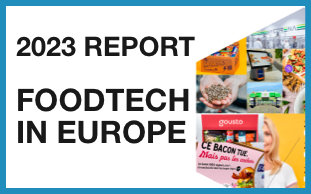Today, I’d like to focus on three graphs on alternative proteins, how to make them more acceptable to consumers, and potential consequences.
1 – How an increased alternative protein adoption could free land?
Green Alliance, a British Think Tank, released a report on the “land dividend” alternative proteins could create in Europe. The idea is simple: increased adoption of these alternatives would free land. Indeed, animals are pretty “inefficient” at transforming what they eat into a new source of calories (with factors ranging approximately from 2 to 10). So, removing the animal from the equation and using what is grown to produce either plant-based products or feed fermentation and cellular agriculture processes would require much less land.
As you can see on the graph below, they studied three scenarios of different “government interventions” (supporting or not innovations) and their respective impact on replacing meat and dairy by 2050 from a mere 20% substitution to almost 70% substitution.

In the less optimistic scenario, and for Europe alone, it would free up land the size of The UK (which we can add Ireland to represent the land freed up in other countries to match imported food). For the most optimistic scenario, it would free up as much land as the size of France (more or less twice as much).
In turn, this would create huge opportunities and challenges. Would this land be used to farm more, rewilding for biodiversity, or to plant forests and act as carbon sinks? This is a topic that leaders in the alternative protein ecosystem don’t mention a lot. It would be interesting to have their opinion and vision on this topic (as well as the policy-makers that support alternative proteins).
2 – What could drive the willingness to buy alternative protein products?
In this consumer study, McKinsey wondered how to better market alternative protein products. We learn that :
- Marketing tech is a very bad idea: quite obviously consumers are wary of food products that are presented as technically-engineered.
- Animal welfare (and the environment) is good argument as a whole to drive the willingness to buy
- Health claims, notably reassuring ones are the best drivers, notably around those that reassure the consumer on the quantity and quality of proteins, and those that can indicate that the alternative is better than the animal-based product.

3 – “Away from home” spending is now bigger than “at home” spending for food

What is even more interesting with this graph is the trend. We don’t see where it will end. Could the growth of restaurant delivery platforms make “food at home” a tiny proportion of our food budget? That’s not something impossible to imagine. If you draw a line, we could have 75% of the money spent of food being spent on restaurants in 20 years. That would represent a huge shift, notably for food brands.
And how does this relates to alternative proteins? Simply by pointing out that brands and innovators should engage more with the foodservice industry. That’s where consumers go to experiment for food rather than in the supermarket. I’ll conclude with a positive stat, something rare in this space: Umiami, a French startup creating innovating plant-based products with an improved texture, said that in restaurants where its products have been sold for a month, it already represents 25% of the sales of the animal equivalents. Not too bad!







